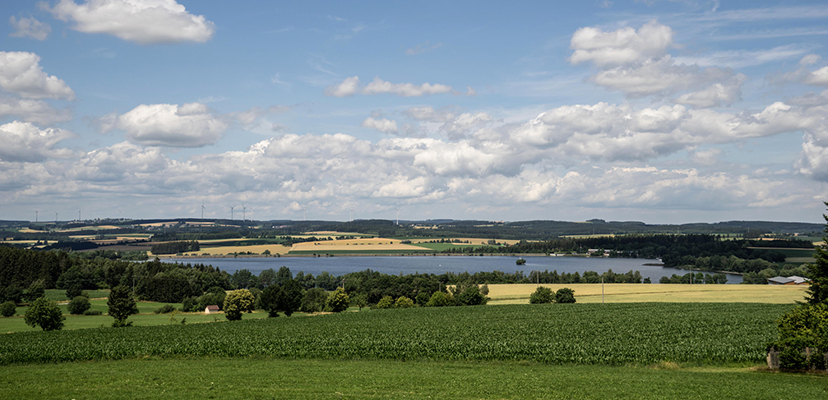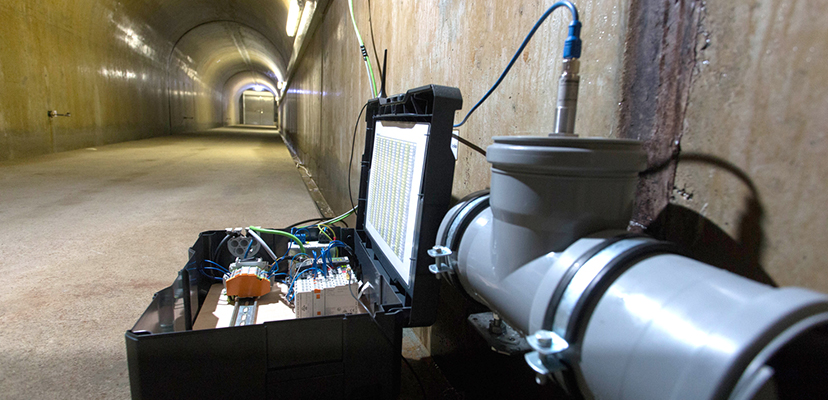


To operate the Förmitztal dam, the water management office HOF measures a variety of water levels of ground, seepage, inflows and outflows. The hydrostatic pressure, which is applied at the opposite measuring point of the dam, is also monitored to guarantee the safety of the dam. The water management office has partly automated the monitored water levels with the help of WAGO as part of the modernization tasks performed since 2013.
The Förmitztal dam, commissioned in 1978 and located in northeastern Bavaria, is one of 24 governmental water reservoirs in the Free State built since the 1950s for the sustainable water management. It consists of a pre-block, a main block and has a total capacity of approximately 10.5 million cubic meters. The core structure is the earthfill dam, which is approximately 800 meters long, 30 meters high and eight meters wide at the dam crest, and includes a control tunnel that has accessible sections.
The Förmitztal dam is mainly used to improve the low water management of the Sächsische Saale, whose spring area is only a few kilometers of the dam at the foot of the Große Waldstein mountains near the small town of Zell. From there, it flows northwest alongside the dam located in the bypass, which is supplied by the drainage area of the Förmitz and a bypass line from the neighboring Lamitz, towards the city of Hof located 18 kilometer away. The control level for the Förmitztal dam is located in Hof. During low rainfall season, normally between July and September, a discharge of at least one cubic meter per second must be provided at this level to ensure that the water protection is guaranteed behind the discharge point of the Hof wastewater treatment plant. Therefore, the water management office provides approximately four million cubic meter water annually.
In addition to the low water increase of the Sächsische Saale, the dam also has a specific high water level protection function of lower importance. In addition, the energy-related water discharge is used with a retrofit turbine that was installed in 1991. Approximately 400,000 kWh are generated annually, which is equivalent to an annual consumption of 125 households. In addition, the water reservoir is also used for local recreation: swimmers, boaters and divers enjoy the facility.
Significant modifications were performed to the measuring equipment in the main dam in 2014. “Up to this point, we manually measured the levels once a week. However, the measuring points were not accessible at times in winter, because they were either snowed in or frozen,” explains Matthias Sudholt, who, with the local colleges, monitors the technology at the dam. A fiber optic cable ring (LWL) was installed alongside the dam in 2014. Since then, the WAGO-I/O-SYSTEM 750 records the levels and transmits them to the control center in the operating building of the dam. It is here, where the data is administered and visualized on a panel.
Interaction of LWL network and WAGO-I/O-SYSTEM 750
The LWL network connects the control center with seven additional points alongside and inside the dam: this includes major intersections of the two control tunnel inputs; the powerhouse with generator is also included. The measuring points of slide cave locking equipment deep inside the dam, which – in combination with the turbine controller – controls the outflow of the water out of the dam into the Sächsische Saale as well as the power house with generator are also included. Several variables including seepage, is measured at the lowest point of the control tunnel, the sump pump.
A total of 40 measurement points for the control of the ground water levels are located on the water and/or air side of the dam. The measurement values, which previously were recorded manually, are routed today through the LWL network to different intersections. This where the data is fed through an ETHERNET switch into the WAGO-I/O-SYSTEM 750 and reported to the control center, where the data is collected and visualized. The dam also includes 30 measurement points for the monitoring of the water pressure. This data is currently still collected on-site. It is the long-term objective of the water management office to transmit all measured data automatically through the network to the control center to visualize and control them there and at different stations on an on-site panel.
The data of the further remote measurement points are currently transmitted through radio signals to the control center and they are fed into the I/O-SYSTEM 750. This includes the levels of the Sächsische Saale in Weißdorf and Hof, the feeds of the Förmitz and Lamitz into the water reservoir, the level of the water reservoir as well as the residual water volume in the Lamitz. The data informs the water management office Hof at any time about the operating condition of the dam and the status of the Sächsische Saale.
Mobile measurement boxes are used to record data at the dam’s measurement points, which do not have to be monitored continuously. The data recorded by the box are stored locally on the controller and they are transmitted via Bluetooth® to the nearest switch cabinet. In addition to the Bluetooth® antenna, a WLAN gateway is installed at the box, which is used to access the WebVisu, for access to the measured data on-site.
Ready to expand
To control the smooth data flow, the water management office uses the WAGO controller with the PFC200 for much of the job. The outside distributor and the Förbau level are exceptions: The standard WAGOI/O-SYSTEM is not used here but rather the XTR variant, because hazardous frequently increases during meteorologic disturbances and this can have a negative effect on the instrumentation and the downstream automation system. “In addition to the 750 series, WAGO also offers the new WAGO-I/O-SYSTEM 750 XTR, which is a customized solution also for such extreme applications,” exclaims Sudholt (see below). The power supply 787-840, which is protected by an EPSITRON®-USV management module (787-870) against unplanned power drops, powers the I/O-SYSTEM for all eight stations.
“The modular design principle of the WAGO system is the biggest benefit. The currently installed system can be expanded in any way by installing the appropriate terminals and boards. The additional components must only be parameterized and connected, an elaborate new programming is not required”, states Sudholt when describing future expansion options for the automatic monitoring of the Förmitztal dam. “In addition, WAGO offers very fast and reliable customer service based on it dense distribution network.”
WAGO-I/O-SYSTEM 750 XTR – Used under extreme conditions
The robust variant of the automation system works reliably even under extreme outside conditions. Extraordinarily high operating safety is guaranteed even with an extended temperature range of -40 °C to +70 °C, which was decisive for the use at the Förmitztal dam. Due to its extraordinary vibration resistance of 5g, which is equivalent to an acceleration of 50 m/s2 and a resistance to continuous shocks of 25g, the system can be installed in direct proximity of intense vibrations and shock generating components. With an increased electric strength, the 750 XTR Series’ electronics are protected against errors. The optimized EMC behavior also prevents negative electromagnetic interference emissions, permitting use in close proximity to highly sensitive third-party systems. The WAGO-I/O-SYSTEM 750 XTR is ideal for use in water management not only due to its greater strength but also because it supports the popular telecontrol protocols per IEC 60870-5-101/-103/-104, IEC 61850-7 and IEC 61400-25 as well as MODBUS.
Text: Kay Miller, WAGO
Photo: WAGO